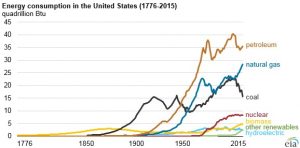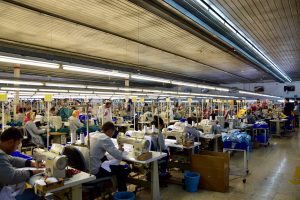Noah Barnes
What are Fossil Fuels?
Fossil fuels are naturally formed fuels that originate from organic materials, such as plants and animals, and pressure from the Earth’s crust along with the passage of hundreds of millions of years. These organic materials break down into crude oil, coal, natural gas, or heavy oils (sciencedaily). In most first world countries, fossil fuels are the leading sources of energy, dominating everything from household machines like cars or heating systems to industrial facilities. Figure (A) shows fossil fuel consumption in the United States over roughly the past 250 years, and it is not difficult to deduce that our consumption of these limited resources has grown exponentially in the past 100 years alone. Since so many processes rely on fossil fuels to function properly, we are consistently pulling these resources out of every nook and cranny we can find. There are two major problems with this mass extraction of resources: (1) these extraction processes can be extremely harmful to the environment, and (2) we are running out of fossil fuels.

What Effects does the Extraction of Fossil Fuels have on the Environment?
Coal, one of the most abundant and useful fossil fuels which has been used to power countless empires throughout history, harbors one of the most harmful methods of extraction: mining and drilling. Over the past several decades, there has been a gradual shift from underground coal mining to surface mining (ucsusa). Underground coal mining carries less harm than surface mining due to the fact that underground mining is… underground. Surface mining involves methods like strip mining (a process that consists of overlaying soil to access the coal below) and mountaintop removal. Because coal mining has only become more streamlined in the past two hundred years, the fact that we can do this faster only means that more habitats and environments will be destroyed.
Another primary fossil fuel on Earth is oil. When oil and gas are extracted, water that had been trapped in the geologic formation is brought to the surface. This “produced water” can carry with it naturally occurring dissolved solids, heavy metals, hydrocarbons, and radioactive materials in concentrations unsuitable for human consumption and difficult to dispose of safely (ucsusa). Due to the mass drilling taking place offshore, harmful toxins found in deeper water are being brought to the surface at an exponential rate. Not only is this water harmful to humans, but also to the habitats of surrounding ocean life. Additionally, pumping oil to the surface not only requires millions of gallons of water, but also 15,000-60,000 gallons of chemicals, many of which are undisclosed to Federal regulators. Researchers could track only 353 chemicals from that larger list and found that 25 percent of those chemicals cause cancer or other mutations, and about half could severely damage neurological, cardiovascular, endocrine, and immune systems (ucsusa).
What do we have planned for the Future?
Sustainable and renewable energy sources are a hot market right now due to the fact that people are finally becoming aware that we are running out of fossil fuels. This means that researchers and investors are constantly looking for new solutions or methods of clean, renewable energy. It may seem like the metaphorical “golden goose” of the modern world due to its seemingly too good to be true nature, but new energy sources are not unobtainable.
Solar and water power are not exactly new, but they aren’t old hat either. More hydroelectric dams – dams which produce energy based on the movement of water, like from a river – are being built across the country every day. Solar power has a bit of a social taboo due to the fact that it is an expensive and not extremely effective solution. However, the Union of Concerned Scientists (UCS) is in the process of reviewing possible federal tax exemptions for those who use solar power to create a financial incentive for more people to use solar. Geothermal and Nuclear energy are a little more volatile and a lot more expensive to maintain, however, the research and testing of these types of energy sources is just beginning, so it would not be unlikely for nuclear and/or geothermal energy to see a spike in both popularity and effectiveness in the near future.
What should we Conclude from this?
To conclude, fossil fuels are quickly becoming a limited resource, and we should expect to see most of them depleted within 100 years (ecotricity). While the harmful environmental effects of fossil fuel extraction may cease because of this (and this is something we should definitely be excited about), humans will still need new sources of energy when we run out of what we have been using. This is the uplifting bit – clean, renewable energy is on the rise not only in the United States, but in a conglomerate of energy-concerned countries worldwide. We will continue to experiment with what we have, pioneer what we can, and hopefully make a breakthrough for renewable energy as soon as possible.
Sources
https://www.sciencedaily.com/terms/fossil_fuel.htm
https://www.ucsusa.org/clean-energy/coal-and-other-fossil-fuels/hidden-cost-of-fossils#.XFOWnM17lPY
https://www.eia.gov/todayinenergy/detail.php?id=26912
https://www.ecotricity.co.uk/our-green-energy/energy-independence/the-end-of-fossil-fuels
(A) U.S. Energy Information Administration, Monthly Energy Review


